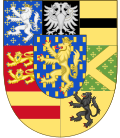This is an old revision of this page, as edited by Blairall (talk | contribs) at 03:08, 27 December 2024 (revised a link and c/e). The present address (URL) is a permanent link to this revision, which may differ significantly from the current revision.
Revision as of 03:08, 27 December 2024 by Blairall (talk | contribs) (revised a link and c/e)(diff) ← Previous revision | Latest revision (diff) | Newer revision → (diff) Branch of the House of Nassau| This article needs additional citations for verification. Please help improve this article by adding citations to reliable sources. Unsourced material may be challenged and removed. Find sources: "House of Nassau-Weilburg" – news · newspapers · books · scholar · JSTOR (August 2015) (Learn how and when to remove this message) |
| House of Nassau-Weilburg | |
|---|---|
 | |
| Parent house | House of Nassau |
| Founded | 1344; 681 years ago (1344) |
| Founder | John I of Nassau-Weilburg |
| Current head | Henri, Grand Duke of Luxembourg (in cognatic line) |
| Titles | |
| Style(s) | His/Her Royal Highness |
| Estate(s) | |
| Dissolution | 1985 (in agnatic line after death of Grand Duchess Charlotte) |
The House of Nassau-Weilburg, a branch of the House of Nassau, ruled a division of the County of Nassau, which was a state in what is now Germany, then part of the Holy Roman Empire, from 1344 to 1806.
On 17 July 1806, upon the dissolution of the Holy Roman Empire, the principalities of Nassau-Usingen and Nassau-Weilburg both joined the Confederation of the Rhine. Under pressure from Napoleon, both principalities merged to become the Duchy of Nassau on 30 August 1806, under the joint rule of Prince Frederick August of Nassau-Usingen and his younger cousin, Prince Frederick William of Nassau-Weilburg. As Frederick August had no heirs, he agreed that Frederick William should become the sole ruler after his death. However, Frederick William died from a fall on the stairs at Schloss Weilburg on 9 January 1816 and it was his son William who later became duke of a unified Nassau.
The sovereigns of this house afterwards governed the Duchy of Nassau until 1866. Since 1890, they have reigned over the Grand Duchy of Luxembourg.
Religion
The first two Grand Dukes of Luxembourg, Adolphe and Guillaume IV, were Protestants, however, the Christian denomination of the house changed after Grand Duke Guillaume IV's marriage to Marie Anne de Braganza, who was Catholic.
Gallery
-
 Weilburg
Weilburg
-
 Weilburg Castle
Weilburg Castle
-
Biebrich Palace
-
 Grand Ducal Palace, Luxembourg
Grand Ducal Palace, Luxembourg
-
 Berg Castle, Luxembourg
Berg Castle, Luxembourg
Sovereigns from the House of Nassau-Weilburg
Nassau
Counts of Nassau-Weilburg
- 1344–71: John I
- 1371–1429: Philip I
- 1429–42: Philip II and John II
- 1442–92: Philip II
- 1492–1523: Louis I
- 1523–59: Philip III
- 1559–93: Albrecht
- 1559–1602: Philip IV
- 1593–1625: Louis II
- 1625–29: William Louis, John IV and Ernst Casimir
- 1629–55: Ernst Casimir
- 1655–75: Frederick
- 1675–88: John Ernst
Princely counts of Nassau-Weilburg
- 1688–1719: John Ernst
- 1719–53: Charles August
- 1753–88: Charles Christian
- 1788–1816: Frederick William
- 1816: William
Dukes of Nassau
Grand Dukes of Luxembourg
Main article: List of Grand Dukes of Luxembourg- 1890–1905: Adolphe
- 1905–12: William IV
- 1912–19: Marie-Adélaïde
- 1919–64: Charlotte
- 1964–2000: Jean
- 2000–present: Henri

Family tree
| Family tree of the House of Nassau-Weilburg | ||||||||||||||||||||||||||||||||||||||||||||||||||||||||||||||||||||||||||||||||||||||||||||||||||||||||||||||||||||||||||||||||||||||||||||||||||||||||||||||||||||||||||||||||||||||||||||||||||||||||||||||||||||||||||||||||||||||||||||||||||||||||||||||||||||||||||||||||||||||||||||||||||||||||||||||||||||||||||||||||||||||||||||||||||||||||||||||||||||||||||||||||||||||||||||||||||||||||||||||||||||||||||||||||||||||||||||||||||||||||||||||||||||||||||||||||||||||||||||||||||||||||||||||||||||||||||||||||||||||||||||||||||||||||||||||||||||||||||||||||||||||||||||||||||||||||||||||||||||||||||||||||||||||||||||||||||||||||||||||||||||||||||||||||||||||||||||||||||||||||||||||||||||||||||||||||||||||||||||||||||||||||||||||||||||||||||||||||||||||||||||||||||||||||||||||||||||||||||
|---|---|---|---|---|---|---|---|---|---|---|---|---|---|---|---|---|---|---|---|---|---|---|---|---|---|---|---|---|---|---|---|---|---|---|---|---|---|---|---|---|---|---|---|---|---|---|---|---|---|---|---|---|---|---|---|---|---|---|---|---|---|---|---|---|---|---|---|---|---|---|---|---|---|---|---|---|---|---|---|---|---|---|---|---|---|---|---|---|---|---|---|---|---|---|---|---|---|---|---|---|---|---|---|---|---|---|---|---|---|---|---|---|---|---|---|---|---|---|---|---|---|---|---|---|---|---|---|---|---|---|---|---|---|---|---|---|---|---|---|---|---|---|---|---|---|---|---|---|---|---|---|---|---|---|---|---|---|---|---|---|---|---|---|---|---|---|---|---|---|---|---|---|---|---|---|---|---|---|---|---|---|---|---|---|---|---|---|---|---|---|---|---|---|---|---|---|---|---|---|---|---|---|---|---|---|---|---|---|---|---|---|---|---|---|---|---|---|---|---|---|---|---|---|---|---|---|---|---|---|---|---|---|---|---|---|---|---|---|---|---|---|---|---|---|---|---|---|---|---|---|---|---|---|---|---|---|---|---|---|---|---|---|---|---|---|---|---|---|---|---|---|---|---|---|---|---|---|---|---|---|---|---|---|---|---|---|---|---|---|---|---|---|---|---|---|---|---|---|---|---|---|---|---|---|---|---|---|---|---|---|---|---|---|---|---|---|---|---|---|---|---|---|---|---|---|---|---|---|---|---|---|---|---|---|---|---|---|---|---|---|---|---|---|---|---|---|---|---|---|---|---|---|---|---|---|---|---|---|---|---|---|---|---|---|---|---|---|---|---|---|---|---|---|---|---|---|---|---|---|---|---|---|---|---|---|---|---|---|---|---|---|---|---|---|---|---|---|---|---|---|---|---|---|---|---|---|---|---|---|---|---|---|---|---|---|---|---|---|---|---|---|---|---|---|---|---|---|---|---|---|---|---|---|---|---|---|---|---|---|---|---|---|---|---|---|---|---|---|---|---|---|---|---|---|---|---|---|---|---|---|---|---|---|---|---|---|---|---|---|---|---|---|---|---|---|---|---|---|---|---|---|---|---|---|---|---|---|---|---|---|---|---|---|---|---|---|---|---|---|---|---|---|---|---|---|---|---|---|---|---|---|---|---|---|---|---|---|---|---|---|---|---|---|---|---|---|---|---|---|---|---|---|---|---|---|---|---|---|---|---|---|---|---|---|---|---|---|---|---|---|---|---|---|---|---|---|---|---|---|---|---|---|---|---|---|---|---|---|---|---|---|---|---|---|---|---|---|---|---|---|---|---|---|---|---|---|---|---|---|---|---|---|---|---|---|---|---|---|---|---|---|---|---|---|---|---|---|---|---|---|---|---|---|---|---|---|---|---|---|---|---|---|---|---|---|---|---|---|---|---|---|---|---|---|---|---|---|---|---|---|---|---|---|---|---|---|---|---|---|---|---|---|---|---|---|---|---|---|---|---|---|---|---|---|---|---|---|---|---|---|---|---|---|---|---|---|---|---|---|---|---|---|---|---|---|---|---|---|---|---|---|---|---|---|---|---|---|---|---|---|---|---|---|---|---|---|---|---|---|---|---|---|---|---|---|---|---|---|---|---|---|---|---|---|---|---|---|---|---|---|---|---|---|---|---|---|---|---|---|---|---|---|---|---|---|---|---|---|---|---|---|---|---|---|---|---|---|---|---|---|---|---|---|---|---|---|---|---|---|---|---|---|---|---|---|---|---|---|---|---|---|---|---|---|---|---|---|---|---|---|---|---|---|---|
|
Compiled from Misplaced Pages and these references. For ancestors of the House of Nassau-Weilburg, see House of Nassau#Family Tree
| ||||||||||||||||||||||||||||||||||||||||||||||||||||||||||||||||||||||||||||||||||||||||||||||||||||||||||||||||||||||||||||||||||||||||||||||||||||||||||||||||||||||||||||||||||||||||||||||||||||||||||||||||||||||||||||||||||||||||||||||||||||||||||||||||||||||||||||||||||||||||||||||||||||||||||||||||||||||||||||||||||||||||||||||||||||||||||||||||||||||||||||||||||||||||||||||||||||||||||||||||||||||||||||||||||||||||||||||||||||||||||||||||||||||||||||||||||||||||||||||||||||||||||||||||||||||||||||||||||||||||||||||||||||||||||||||||||||||||||||||||||||||||||||||||||||||||||||||||||||||||||||||||||||||||||||||||||||||||||||||||||||||||||||||||||||||||||||||||||||||||||||||||||||||||||||||||||||||||||||||||||||||||||||||||||||||||||||||||||||||||||||||||||||||||||||||||||||||||||
References
- "Inoformation of the reigning House of Nassau-Weilburg". luxembourg.public.lu/en/index.html. Archived from the original on 2019-10-22. Retrieved 2019-11-03.
- ^ "Inoformation of the reigning House of Nassau-Weilburg which explicitly states the House of Nassau as its parent house" (PDF). sip.gouvernement.lu/en.html.
- Louda, Jiri; Maclagan, Michael (December 12, 1988), "Netherlands and Luxembourg, Table 33", Heraldry of the Royal Families of Europe (1st (U.S.) ed.), Clarkson N. Potter, Inc.
- Hay, Mark Edward (1 June 2016). "The House of Nassau between France and Independence, 1795–1814: Lesser Powers, Strategies of Conflict Resolution, Dynastic Networks". The International History Review. 38 (3): 482–504. doi:10.1080/07075332.2015.1046387. S2CID 155502574.
| — Royal house —House of Nassau-Weilburg | ||
| New dynasty partitioned from Cty. of Nassau |
Ruling house of Nassau-Weilburg 1344–1806 |
Nassau-Weilburg merged in Ducal Nassau ruled by the House of Nassau-Usingen |
| Preceded byHouse of Nassau-Usingen | Ruling house of the Duchy of Nassau 1816–1866 |
Nassau annexed by Prussia |
| Preceded byHouse of Orange-Nassau | Ruling house of Luxembourg 1890–present |
Succeeded byIncumbent |
| Royal houses of Luxembourg | |
|---|---|
| Ecclesiastical |  | ||||
|---|---|---|---|---|---|
| Secular | |||||
| Counts / Lords |
| ||||
| Cities |
| ||||
| Part of the Three Bishoprics. Nomeny after 1737. without Reichstag seat. until 1736. Joined Swiss Confederacy in 1515. Circles est. 1500: Bavarian, Swabian, Upper Rhenish, Lower Rhenish–Westphalian, Franconian, (Lower) Saxon Circles est. 1512: Austrian, Burgundian, Upper Saxon, Electoral Rhenish · Unencircled territories | |||||